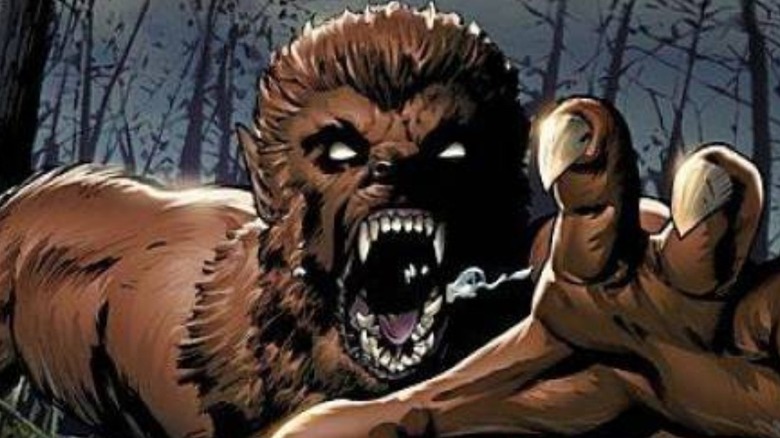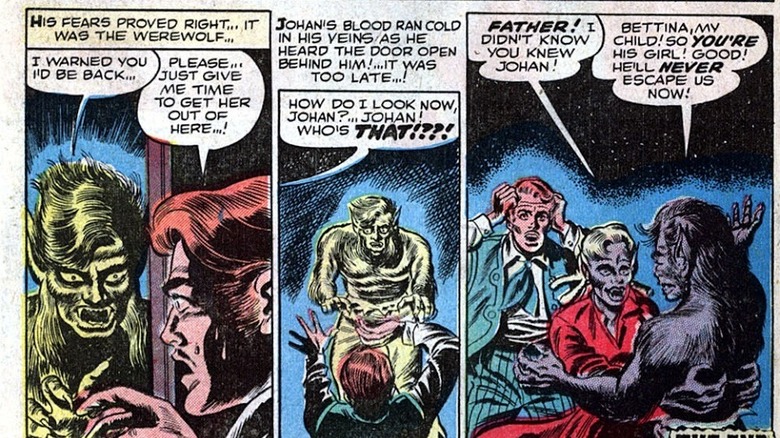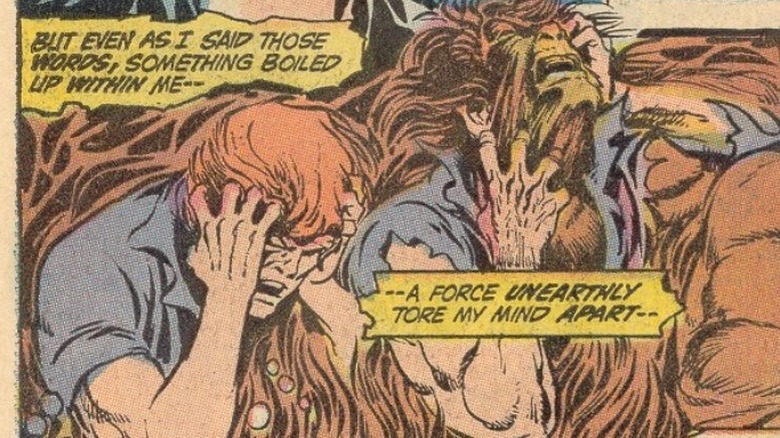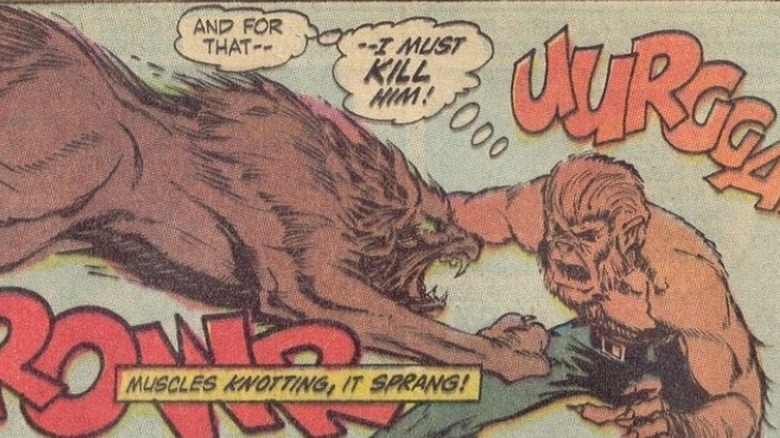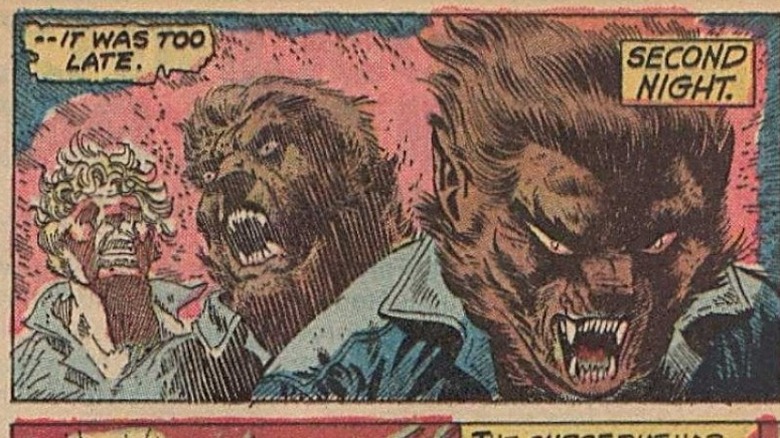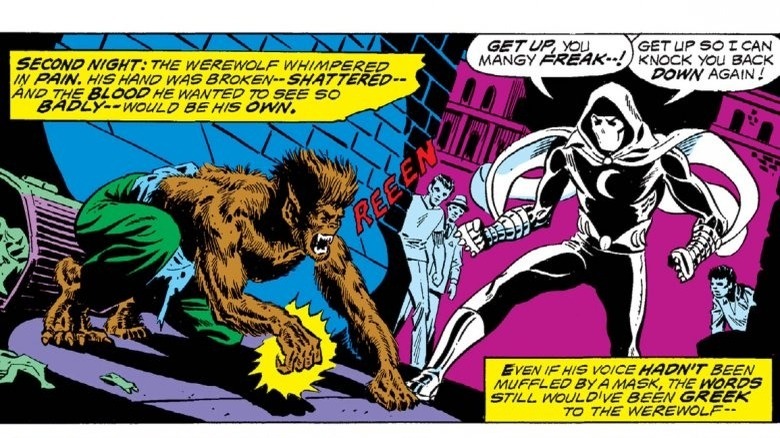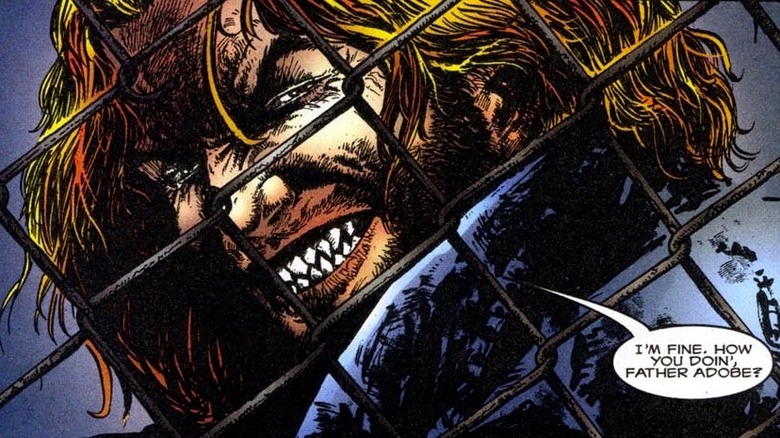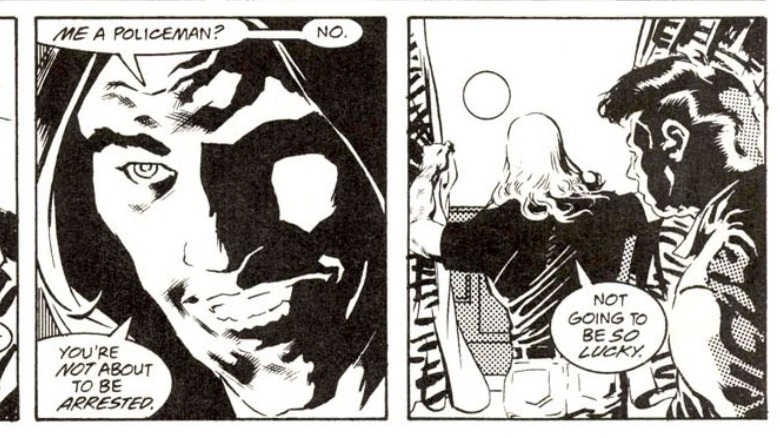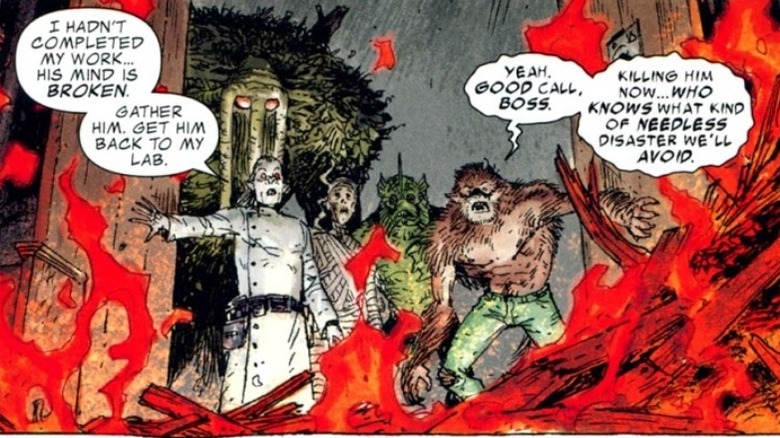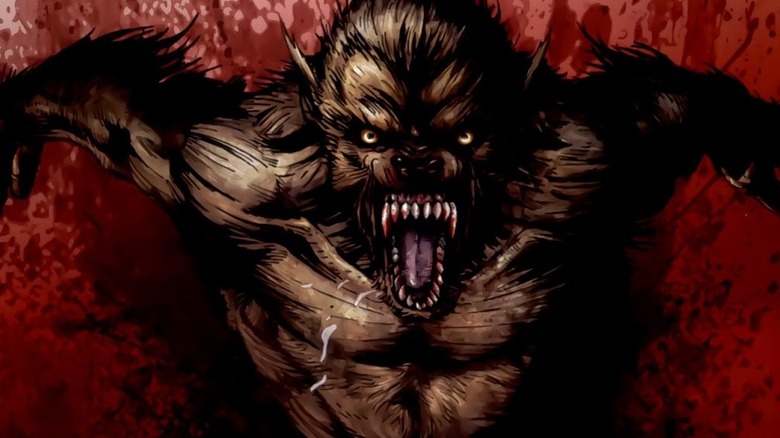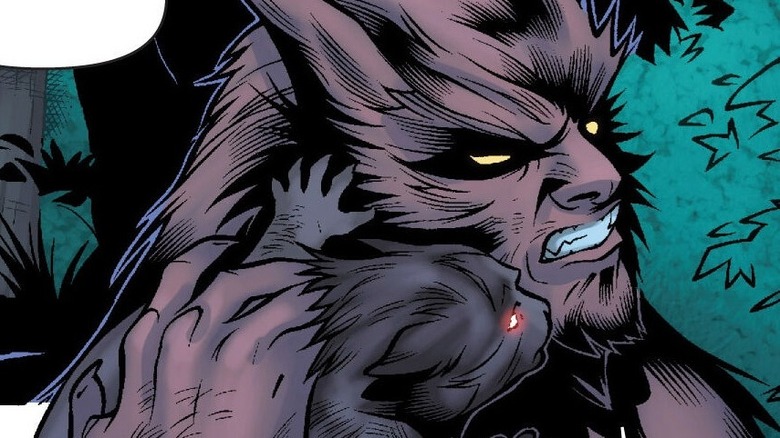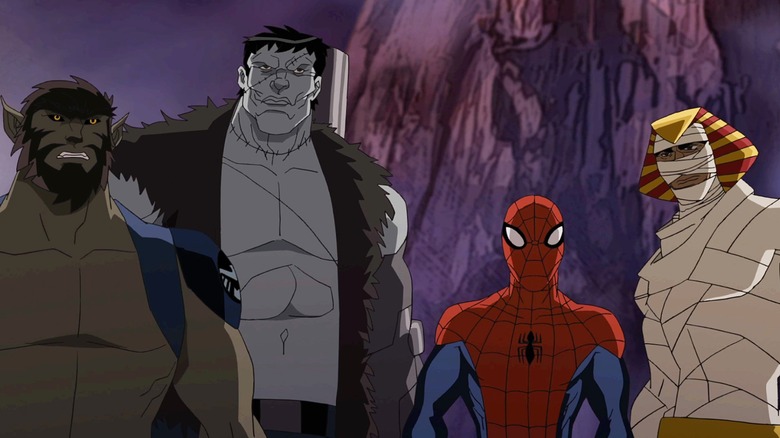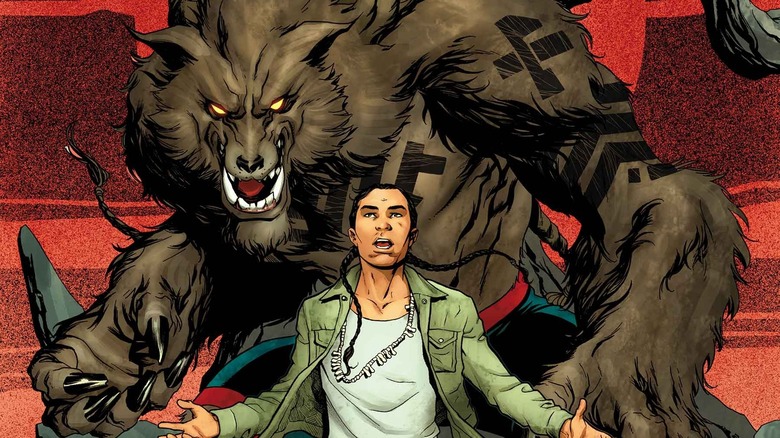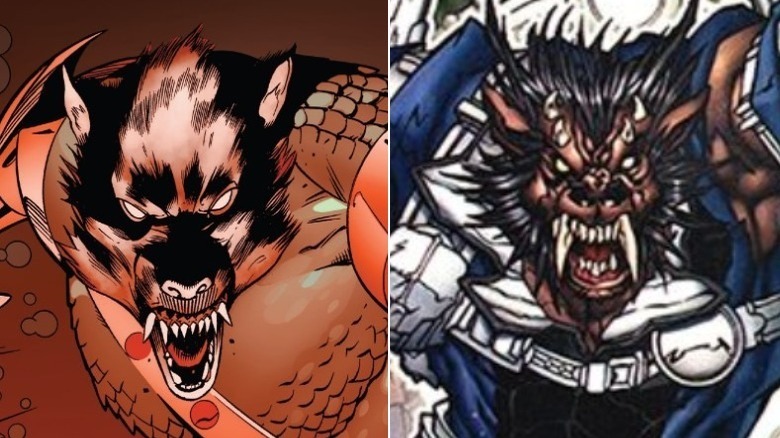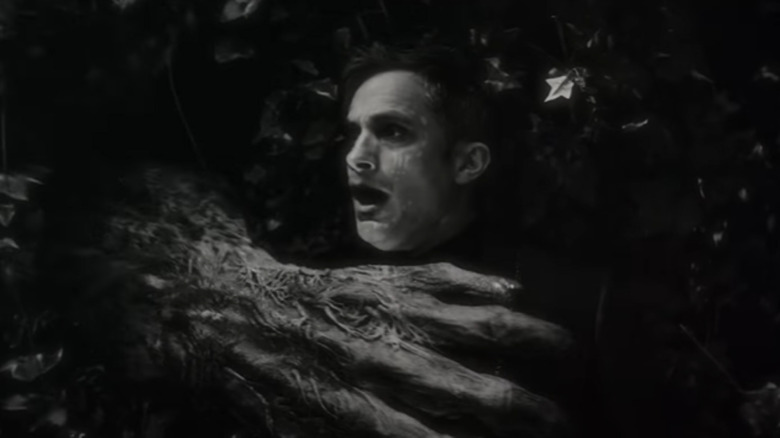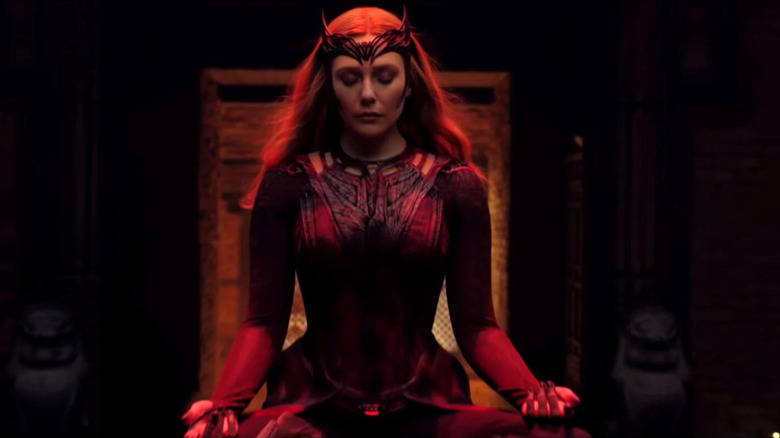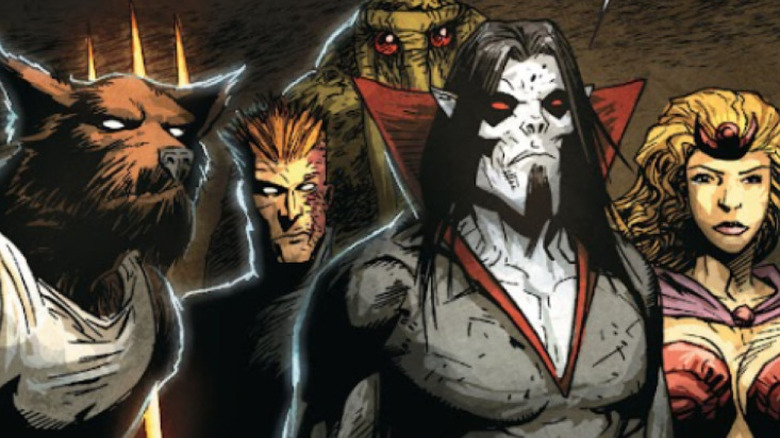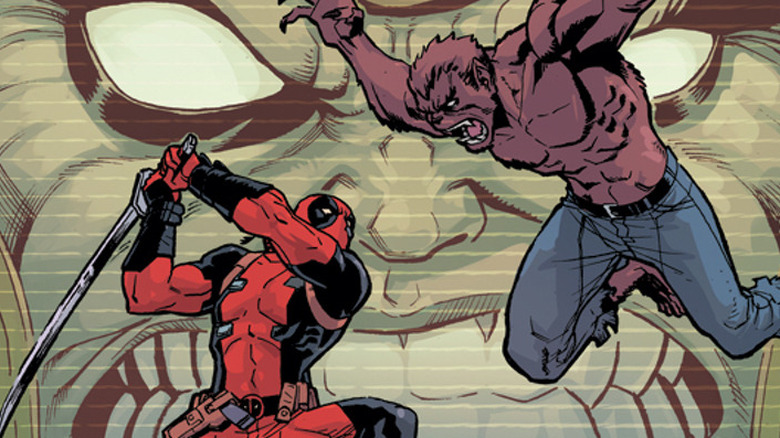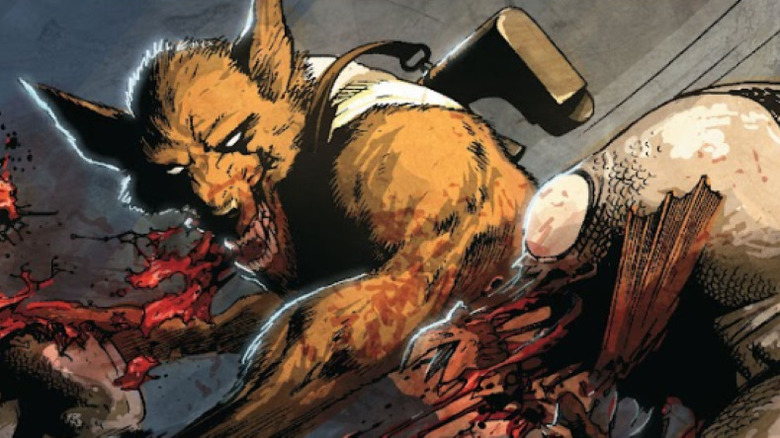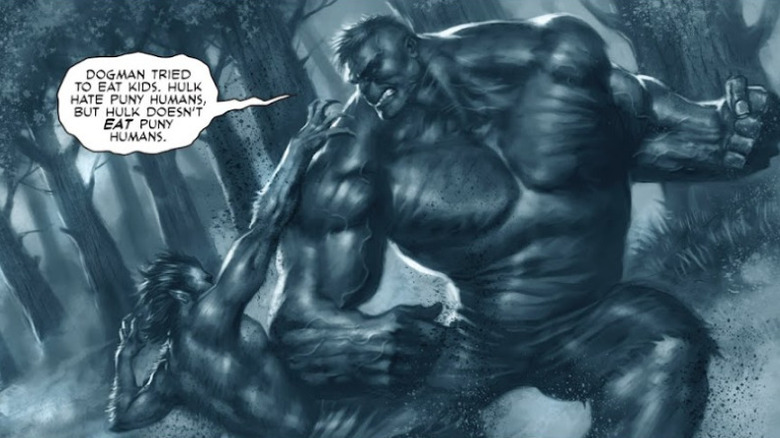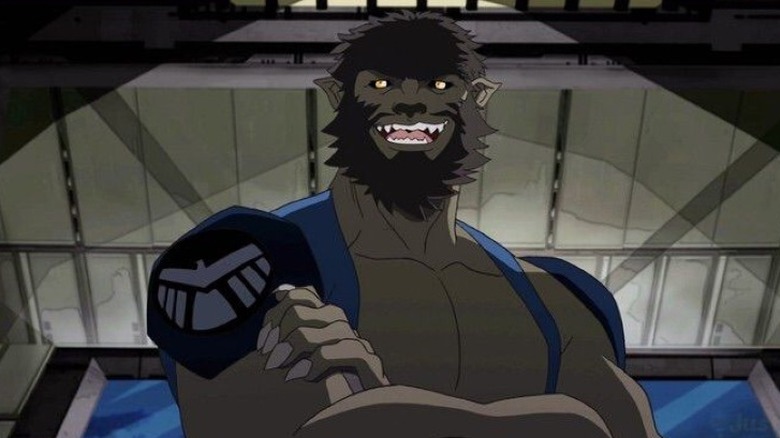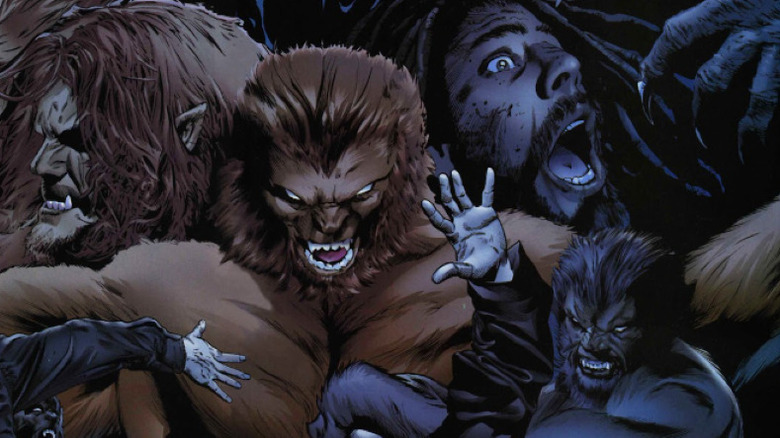The Untold Truth Of Werewolf By Night
When you think of Marvel Comics you probably think of Spider-Man, the X-Men, the Hulk, et cetera. But the Marvel Comics Universe encompasses more than just superheroes and supervillains. Long before Marvel's early '60s success with superheroes, it was involved with other genres, including horror. When the Comics Code Authority loosened up on some of its restrictions in 1971 — including doing away with most of its rules designed to stop all publication of horror comics — Marvel used the opportunity to expand the genres it covered and it folded most of their new horror comics into the same narrative universe as its more popular superheroes. Along with well-remembered '70s series like "Tomb of Dracula" and "Man-Thing," Marvel's re-investment in horror led to the series "Werewolf by Night."
While the title predated him by a couple of decades, it was Jack Russell who would be the first character to become known as Werewolf by Night. Enjoying extreme dips and crests in popularity, Werewolf by Night has gone long periods without being a blip on anyone's radar in Marvel. But because of some recent changes to the concept as well as renewed interest, the lycanthrope's unusually long name may be a lot more widely recognizable soon. This is the untold truth of Werewolf by Night.
The earliest Werewolf By Night was very different
Before Jack Russell or any other characters by the name of Werewolf by Night showed up in Marvel, the name was used as the title of an odd horror story in an anthology comic.
In 1953's "Marvel Tales" #116, the story "Werewolf by Night" transports the reader to Vienna of the late 19th century where the young and handsome Johan hopes to win the hand of the lovely Bettina, but Johan worries he doesn't have the wealth necessary to impress his beloved. After a costume party he uses his scary monster outfit to frighten a wealthy man out of his money, only to have the robbery interrupted by an actual werewolf.
Johan flees, but the werewolf finds his home and forces the young man to let him sleep there. The next morning the werewolf has transformed into a normal human man — somehow in a business suit — who blackmails him. Johann continues to rob the wealthy, and he leaves his victims for the werewolf to feed on. The story ends with the werewolf interrupting Johan and Bettina during a date, when Bettina reveals that not only is she a werewolf, but the werewolf blackmailing Johan is her father.
The Werewolf By Night is born
When we first meet Jack Russell in 1972's "Marvel Spotlight" #2, he isn't himself. Having transformed into his more wolflike form, Russell is about to kill a mugger before a police officer intervenes. When Russell wakes the next morning, he thinks the whole thing was just a dream. But the episodes continue without Jack knowing why until he visits his mother on her deathbed. She reveals that lycanthropy is part of Russell's lineage. While they were living in what she refers to only as "a Baltic state," Russell's father would lock himself in part of the family castle during the nights of the full moon, until one night he managed to escape his confinement and — after killing a local man — was hunted down and killed by the townsfolk.
In 1974's "Werewolf by Night" #15 Russell learns his origin story is tied to another Marvel monster — Marvel's Dracula. Russel learns the first werewolf in his family line was the Transylvanian Grigori Russoff who hunted and staked Dracula — one of Dracula's many deaths — after the vampire killed his wife. In return Dracula's servant, the werewolf Lydia, bit Russoff and left him with the curse of lycnathropy.
The funniest joke about Jack Russell's name was unintentional
Longtime Marvel writer Gerry Conway shares co-creator credits on Werewolf by Night with artist Mike Ploog, former Marvel Editor-in-Chief Roy Thomas, and Roy's then-wife Jean Thomas. According to a 2014 interview with Conway in "Back Issue" #71, it was Roy and Jean who plotted Jack Russell's first appearance in "Marvel Spotlight" #2 before turning the writing duties over to Conway. Conway would go on to write all of the character's appearances in "Marvel Spotlight," the first four issues of "Werewolf by Night," and a number of other issues throughout the series.
It was Conway who gave Werewolf by Night the name Jack Russell — a name most have naturally assumed to be a joke, because of the dog breed known as Jack Russell Terriers. But according to what Conway told "Back Issue," the joke was completely unintentional.
Conway explained that when he was writing the character he didn't own a dog and hadn't grown up with them. "The idea of calling a character Jack Russell — who turns into a werewolf — probably would've struck me as hilarious if I had thought of it," Conway explained, "but I don't think I did."
The Wolfman
Comic book series tended to go through a lot more writing and art team changes in the '70s than they do these days. Doug Moench would eventually prove to be the most consistent "Werewolf by Night" writer on the character's first solo series; Moench's tenure begins with 1974's "Werewolf by Night" #20 and stretches uninterrupted until the end of the series with 1977's "Werewolf by Night" #43, including all four of the accompanying "Giant-Size Werewolf" issues.
But before Moench, Marvel made a writing choice that seems as inevitable as it was fun. Marv Wolfman — who you may remember from his cameo in the CW's "Crisis on Infinite Earths" crossover — was tapped to write the comic starting with 1973's "Werewolf by Night" #11. Next to Wolfman's name at the top of the issue's first page, the editor added the note, "At last — Werewolf — written by a Wolfman." Wolfman's tenure ended with #15, in which Werewolf by Night clashes with Dracula and learns of how the legendary vampire factors into his cursed heritage.
He helped start another Marvel legend's career
Particularly toward the end of his first solo series, Jack Russell's exploits found him coming into contact with more well-known Marvel characters like Iron Man and Brother Voodoo. In one case, however, he helped introduce a brand new Marvel hero, though he wasn't acting very heroic at the time.
Marc Spector, aka Moon Knight, is a mercenary hired to capture Jack Russell when he's introduced in 1975's "Werewolf by Night" #32. Armed by the enigmatic group the Committee with silver weapons, Spector succeeds in capturing Russell but later regrets his decision and help him escape. Still, Moon Knight isn't treated like a saint even after he helps free the werewolf. The last we see of him in "Werewolf by Night" #33, he's crouched on a rooftop and with the fat stack of bills he took from his former employers.
When it came time to make Moon Knight more of a hero, this story was retconned so that Spector was actually working undercover to find out about the Committee, who would go on to make more trouble for Moon Knight.
Werewolf by Night's '90s revival
After his solo series closed its doors, Jack Russell's appearances in the Marvel Universe were sporadic until the '90s saw a revival of mystic and horror-themed comics like "Doctor Strange" and "Ghost Rider." Werewolf by Night made guest appearances in those comics and eventually became a member of the Midnight Sons: a loose-knit, magical-themed team that at different times included members like Blade, Doctor Strange, Ghost Rider, Morbius, and Man-Thing.
Marvel greenlit a second stab at an ongoing "Werewolf by Night" series in 1998 with the Eisner-winning Paul Jenkins writing and art by Leonardo Manco. The series opens with Russell setting out on a quest to finally cure himself of his more lupine, monstrous half. Predictably, Russell fails to cure himself, and he also unfortunately failed to bring in the readers. The new "Werewolf by Night" series folded with its sixth issue.
A troubled past
One of Werewolf by Night's darkest tales comes in a little-remembered story in the 1998 black and white anthology series "Shadow and Light." In the series' third and final issue Jim Starlin — the creator of Thanos — and artist Tom Grindberg came together to make "Even the Beast Hates!" The story opens with Jack Russell's more monstrous half finding a child's body in the woods. When Russell re-emerges, he tracks the child predator who murdered the boy and lets his wolf side exact justice.
For the first time in Russell's history, we learn that he was sexually abused as a child and that his attacker got away. As the werewolf begins his pursuit of his new victim, the narration reads that even though his prey isn't the same man who dragged Russell into an abandoned building, that he's "close enough for the beast." More than anything, the story implies that it's Russell's childhood trauma that fuels the savagery of the wolf within.
The Legion of Monsters
In 1976's "Marvel Premiere" #28 Werewolf By Night, Morbius, Man-Thing, and Ghost Rider briefly become known as the Legion of Monsters when they team up to battle an ancient alien known as Starseed. The ragtag group wouldn't survive long, but they would re-emerge during one of the strangest periods of the life of Frank Castle, aka the Punisher.
In the 2009 one-shot "Dark Reign: The List — Punisher," Wolverine's son Daken kills Frank Castle by literally hacking him to pieces. In "Punisher" #11, the vigilante returns a changed man. Playing the part of mad scientist, Morbius resurrects Punisher as Franken-Castle: a cybernetic, undead mash-up of the Punisher and Frankenstein's Monster.
In his new life, Castle learns that the Legion of Monsters has reunited — minus Ghost Rider and with new additions of the Living Mummy and Manphibian — with the mission of protecting other monsters being hunted by humans. The story takes place during a period in which Jack Russell's personality is dominated by his werewolf side, and he spends most of his time bickering with the Legion's leader Morbius.
The Dead of Night
When the comics code restrictions eased up in the early '70s, along with seeing what they could do with solo horror-themed properties, Marvel once again experimented with horror anthology series. In 1973, "Dead of Night" #1 hit the stands — though apparently Marvel had done too good a job in conditioning its audience to superhero fare and single-story titles, because "Dead of Night" folded after only 11 issues.
Apparently, however, the title left an impression because along with the reintroduction of the Legion of Monsters, Marvel resurrected "Dead of Night" as part of its adults-only MAX line of comics. Man-Thing got his own "Dead of Night" miniseries as did the mystic warrior Devil Slayer, and of course there was "Dead of Night Featuring Werewolf by Night," written by Duane Swierczynski with art by Mico Suayan. The story is a murder mystery, with Jack Russell as the prime suspect. Russell races to prove his innocence while at the same time not being completely sure he isn't guilty.
"Dead of Night Featuring Werewolf by Night" is only four issues long, but as part of the MAX line, it packs in more blood and gore than just about every other appearance of the character combined.
He raised Wolfbane's son
You don't usually think of a character like Werewolf by Night in connection with Marvel's mutants, but Jack Russell got tangled up in the lives of one of the most tragic of all of Marvel's mutants — Rahne Sinclair, aka Wolfsbane.
During a now-classic 1985 storyline going through "New Mutants Special Edition" #1 and "Uncanny X-Men Annual" #9, the shape-shifting Wolfsbane meets Hrimhari, the wolf prince of Asgard. Years later, the pair conceive a child, though Hrimhari dies before he is born. Upon his birth in 2011's "X-Factor" #224, their son, Tier, is wolflike just like his father and his first act upon birth is to kill a man. In disgust, Rahne rejects and abandons Tier, but the young pup finds salvation in the form of Werewolf by Night.
Because of his mystical heritage, Tier ages rapidly as Werewolf by Night raises him. Sadly, nothing Jack Russell can teach Tier is able to save him. We learn Tier is a figure of prophecy and his birth ushers in the Hell on Earth War, in which different underworld figures like Mephisto, Pluto, and Satannish battle for dominance. In 2013's "X-Factor" #256, Tier comes close to defeating Mephisto, but at the last moment Strong Guy runs him through from behind with a trident, killing him.
Werewolf by Night and the Howling Commandos
In 2005, Keith Giffen had a stroke of genius. He took the name "Howling Commandos" — usually attributed to the elite fighting force that accompanies Nick Fury during World War II in the comics, though it's Captain America they follow in the MCU — and focused on the "Howling" part of the name. And so the short-lived series "Nick Fury's Howling Commandos" was born with a special-ops team made up of both old and new Marvel characters like the Living Mummy, Frankenstein, and Warwolf. That's right: instead of using the perfect opportunity to reintroduce Werewolf by Night, Giffen created an entirely new wolf guy.
It would take until 2015 for the comics to make this right by bring Russell into a similar team, first in the 2015 "Secret Wars" tie-in miniseries "Mrs. Deadpool and the Howling Commandos," and later that year with "Howling Commandos of SHIELD."
But the animated world stepped up and corrected the problem first. In 2013, toward the end of Season 2 of the Disney XD animated series "Ultimate Spider-Man," Werewolf by Night appears in "Blade and The Howling Commandos," joined by the Living Mummy, Frankenstein's Monster, and Man-Thing. Together they help Spider-Man retrieve a mystical ankh from Dracula.
Jake Gomez, the new Werewolf By Night
While Jack Russell still exists within the Marvel Universe, in 2020 Marvel introduced a brand new version of Werewolf by Night. Benjamin Jackendoff co-wrote the series with Taboo — rapper and member of the Black Eyed Peas. Instead of Jack Russell, the new Werewolf by Night is a native boy named Jake Gomez whose lycanthropy emerges when he's only 13 years old. Gomez's wolf form is very different from Russell's. While the original Werewolf by Night looks more or less like Lon Chaney Jr. in the 1941 classic "The Wolf Man," Gomez's wolf form is much taller and bulkier — almost Hulk-sized.
Unlike Russell's early adventures, Gomez has a more specific mission beyond finding out about his own condition: He locks horns with the corrupt company Life Pharmaceuticals, which is kidnapping native people for insane experiments. He eventually finds an ally in the hero Red Wolf, who teaches the boy to control his abilities in ways that Russell rarely could.
The other Marvel werewolves
Werewolf by Night — regardless of which version you're talking about — isn't the only werewolf in the MCU, nor is he the only man-wolfish kind of guy.
Spider-Man's mythology includes its very own wolfman with the not particularly tough-to-remember name of Man-Wolf. The white-furred Man-Wolf's alter ego is John Jameson, son of the ornery J. Jonah Jameson. The astronaut begins changing back and forth between man and wolfman after discovering a gem on the surface of the moon, and has actually appeared a couple of times in live-action films. Daniel Gillies plays him in 2004's "Spider-Man 2" and Chris O'Hara plays him in 2018's "Venom," but in neither case does he wolf out.
Then there's Warwolf, the guy who originally stole Werewolf by Night's spot on the Howling Commandos. There are actually a couple of different characters named Warwolf, and both get their paychecks from S.H.I.E.L.D. The first is Vic Marcus from "Nick Fury's Howling Commandos" who is able to turn into a werewolf at any time of day because his change is governed by Mars. Introduced later in 2015's "S.H.I.E.L.D." #9 is Martin Reyna, whose lycanthropy comes from a genetic enhancement.
Werewolf by Night Halloween Special
The Marvel Cinematic Universe has never been afraid of producing features about some of its most obscure comic characters. Arguably, before Iron Man kicked off the entire "Avengers" initiative, he was a B-grade character whose comic's mainstream popularity lagged behind more well-known titles like "Spider-Man" and "X-Men." Truthfully, "Guardians of the Galaxy" and "Ant-Man" were even deeper pulls from a rich roster of famous personalities — and the company is showing no sign of slowing down on pulling out relatively little-known names to headline in their own shows and movies.
For example, look no further than the Halloween Special slated to be released on Disney+ in October 2022. Despite the heavy rumors, it wasn't until September 2022's D23 event that the company officially announced the special would be based around the Jack Russell incarnation of Werewolf by Night. Much like the source material, the "Werewolf by Night" trailer showcases a film tribute to the classic monster movies of yesteryear. Set for release on October 7, 2022, "Werewolf by Night" will also include the long-awaited MCU arrival of another comic book monster, Man-Thing.
Connection to the Darkhold
Surprisingly, Werewolf by Night's origins in the Marvel Cinematic Universe may have already been revealed. The character of Jack Russell inherited his wolven curse from his late father, but how his father gained these powers has a connection to the MCU's most mystical adventurers. Rewinding back to the start of Marvel's Phase Four, "WandaVision" initiated many of the themes explored in the cinematic universe as of late. Aside from launching a spinoff in "Agatha: Coven of Chaos," the Scarlet Witch's actions in the series led to disastrous multiversal repercussions in "Doctor Strange in the Multiverse of Madness." Specifically wreaking havoc was Wanda's study of the Book of the Damned, also known as The Darkhold.
The Darkhold's influence corrupted Scarlet Witch into murdering anyone who stood in her way of reconnecting with her children. And while the book was destroyed in the events of "Doctor Strange in the Multiverse of Madness," it may have already had further implications across the MCU. The Darkhold's first appearance in a comic book came in the 1971 Werewolf by Night story from the fourth issue of "Marvel Spotlight." In the issue, Jack Russell learns that his late father was a practicing warlock who owned the powerful tome. Later, in the 1972 miniseries "Werewolf by Night," it's revealed that Jack's father used the book to gain werewolf powers, which Jack inevitably inherited.
The Midnight Sons
Being significantly tied to the lore of classic monsters, Werewolf by Night is inherently ingrained in the occult storylines of Marvel Comics, and Jack Russell has been closely associated with the comic universe's leading occult-focused superhero team, Midnight Sons. Traditionally centered around Ghost Rider, the Midnight Sons' ranks have included Doctor Strange, Blade, Morbius, Elsa Bloodstone, and many more recognizable characters. Appearing in multiple crossover events throughout the '90s, the Midnight Sons are essentially an Avengers-type team defending the planet from magical forces.
In particular, the Midnight Sons have encountered the Darkhold on more than one occasion; in fact, the team originally included the members of the Darkhold Redeemers — another supernatural crew tasked with protecting the mystical book. With the arrival of Werewolf by Night, the MCU would appear to be inching closer to the arrival of either of these mystical super-teams. Arguably, as the film and television franchise dives deeper into the supernatural entities of Earth-616, the Midnight Sons could be arriving sooner than we think — and its members would likely include Werewolf by Night.
He slept with Deadpool's wife
Unfortunately, the Jack Russell iteration of Werewolf by Night was absent from the Marvel Comics universe for many years, but the character made his triumphant comeback in the 2022 "Moon Knight Annual." Coincidentally dropping around the same time as the arrival of the Disney+ Halloween special, the story pits Moon Knight and Werewolf by Night against each other as they relive their long history. Surprisingly, this will be Russell's first meaningful comic book appearance since an uncomfortable run-in with Deadpool back in 2016.
This run-in took place during the fourth volume of "Deadpool." Issue 17 of the run, written by Gerry Duggan, the titular merc with a mouth returns to his home in Monster Metropolis after spending significant time away from his wife, Shiklah, the former Queen of the Undead. Unfortunately, their relationship is seemingly past saving as Deadpool finds his wife in bed with Jack Russell. No room for explanation, the regenerating degenerate takes Werewolf by Night's head off with a shotgun. Thankfully, Russell's lycanthropy includes a healing factor that eventually rejuvenates and restores the wolf's noggin. However, the repercussions of the adulterous evening launched Deadpool and his betrothed into an all-out war ending in their separation.
He helped end a zombie plague
Marvel has a rich history of including classic horror monsters in their comic books, and that includes a number of undead characters. Long before zombies started tearing the Avengers apart in the animated Disney+ series "What If... ?," the brain-craving beasts tore their way through the pages of comic books, specifically in the groundbreaking "Marvel Zombies" limited series, published in 2005-'06, which featured the undead taking on Earth's mightiest heroes. Written by zombie aficionado Robert Kirkman, the story involved a zombie plague taking over an alternate Earth before being spread throughout the galaxy.
In "Marvel Zombies 4," published in 2009, the zombie plague finally reaches the main Marvel Universe, Earth-616. Thankfully, an unlikely group of heroes is tasked with saving the planet — specifically, you guessed it, the new Midnight Sons. Headed by Morbius, who has developed a vaccine, the group includes Werewolf by Night, Man-Thing, Daimon Hellstrom, and Jennifer Kale. The four-issue series centers on the Midnight Sons' efforts as they manage to contain the zombie plague using a unique combination of magic. Unfortunately, the virus survives the saga thanks to the decapitated head of Deadpool — and it continues to thrive throughout the galaxy, as the MCU will prove with its "Marvel Zombies" animated series.
He singlehandedly defeated the Hulk
If you want to know how tough any Marvel Comics character really is, you pit them against the gold standard of strength, the Incredible Hulk. Arguably, this was the thinking when the publishing company released 2008's "Hulk Monster-Size Special" one-shot, which posted the eponymous beast against a selection of classic monsters, including Frankenstein's Monster and Dracula. The anthology-style comic also features a short story by Steve Niles and Lucio Parrillo that lined up a one-on-one throwdown between "the strongest there is" and Werewolf by Night.
The story involves a random encounter between Jack Russell and Bruce Banner, with the former offering to pay the latter to cage him up through the full moon-illuminated evening. Of course, when Russell inevitably transforms into a werewolf, Banner follows suit in becoming the bruising Hulk and begins to prove his dominance. However, the speedier Werewolf by Night manages to get his jabs in on his much larger foe before landing a chokehold that knocks the Hulk out. By the time a disoriented Banner wakes up, Russell is long gone, leaving nothing but a note — and payment in full.
Multiple cartoon appearances
In spite of his inconsistent presence in Marvel Comics, Werewolf by Night has grown into a fan-favorite character over the years, and Jack Russell has also appeared in other superhero media, much to the enjoyment of Marvel-loving monster enthusiasts everywhere. Aside from the aforementioned arrival in the "Ultimate Spider-Man" animated series alongside Blade and Man-Thing, Werewolf by Night has made some other surprising cameos.
Jack Russell's first television appearance came in the second season of the animated children's series "The Super Hero Squad Show." Performed by legendary voice actor Rob Paulsen, Werewolf by Night teams up with Man-Thing to help Iron Man safely return to his own world. The wolven character would later appear, this time voiced by Nolan North, in "Hulk and the Agents of S.M.A.S.H." during the second-season episode "The Hulking Commandos." The monster-centered story includes Werewolf by Night once again joining the Howling Commandos' ranks alongside the Living Mummy and Frankenstein's Monster as they face off against the powerful Dormammu. Finally, Jack Russell has also broken into the video game realm as a playable character in both "Super Hero Squad Online" and "Marvel Avengers Academy."
There was almost a Werewolf by Night movie
Long before the Marvel Cinematic Universe took over the box office, serious consideration was given to making Werewolf by Night the star of his own blockbuster film. The first rumblings of this monster movie reach back to 2001, as reported by Variety. The now-legendary Marvel chief Kevin Feige was at the center of conceptualizing and developing the would-be creature feature and said about the film, "If you're a fan of werewolves, it's the kind of action you've always wanted to see."
Development of the "Werewolf by Night" movie moved extremely close to full-on production. By 2004, the film had a script written by Hans Rodionoff and Robert Nelson Jacobs, a director in John Fasano, and a fantasy-romance theme that Superhero Hype said leaned towards an R rating. Finally, with a cast announcement expected and filming estimated to begin in 2006, the film failed to materialize without a word from the producers. All this is not to say that Feige let go of the project — after all, he wouldn't allow Kevin Smith to use Werewolf by Night in his planned Howard the Duck animated series.
